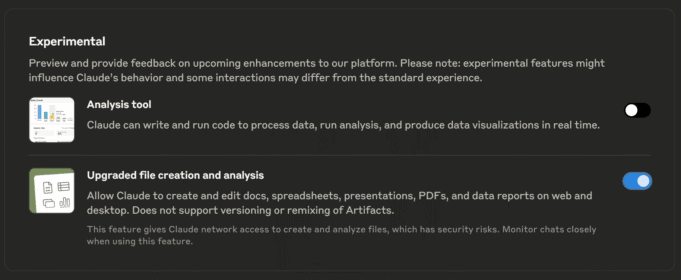- Claude can now create and edit Excel spreadsheets, PowerPoint decks, Word docs, and PDFs.
- File creation transforms Claude from advice-giver into active project collaborator.
- Available today in preview for Max, Team, and Enterprise users.
Claude just went from giving pointers to building the actual files. Anthropic’s AI assistant can now create working Excel models, convert data into charts, and even reformat a PDF report into a PowerPoint presentation.
“It’s like moving from an advisor sitting at the table to a colleague typing next to you,” Anthropic says.
How it works
Inside Claude.ai and the desktop app, users can now upload raw material or describe what they need. Anthropic says Claude then operates in a private computer environment where it can write code, crunch numbers, and output ready-to-use files.
Think of it like this:
- Raw CSV –> Clean data with analysis and charts
- PDF report –> Polished PowerPoint deck
- Meeting notes –> Formatted Word doc
- Budget request –> Spreadsheet with working formulas

Claude Connector: A Gateway Drug to Doc Overload?
I’ve been living this shift already with Claude’s Notion connector. My workspace is overflowing with documents now. I use it for brainstorming sessions for Stark Insider articles, creating (too much) detailed documentation for our upcoming Vertigo AI server build, and developing project plans for just about everything. Every configuration change, every server tweak, it all goes into Claude-generated Notion docs.
Far too many documents? Maybe. Well, definitely. But when I need to troubleshoot NGINX configs, having every server change documented and searchable saves me time. That’s just with the Notion connector. Now Claude can build actual files.
Why it matters for casual users
For students, freelancers, or anyone working with a lot of data, this feature turns hours of manual effort into a few prompts. Imagine handing Claude your expense receipts and getting back an organized budget sheet, or uploading meeting notes and downloading a formatted doc for class.
We could perform these tasks previously with LLMs, but the difference here is Claude can directly create and edit. You no longer need to copy and paste, saving time and resulting in faster results.
Why it matters for business users
This is workflow compression. For example, data scientists can skip the drudgery of cleaning data and focus on insights. Marketing teams can hand Claude a PDF and get a deck for tomorrow’s client call. Financial analysts can test scenarios without building models from scratch.
Yes, there are caveats, no doubt. The feature gives Claude internet access, which means data security requires vigilance. Businesses especially will want to keep sensitive datasets under tight guardrails.
And, my advice: test this feature first on critical projects and files. Make sure you are monitoring and cross-checking all the work that Claude does and that it’s not hallucinating. On more than one occasion with Claude Connector for Notion, I’ve had sections of documents get mangled because it used HTML tags, for instance, instead of Notion-compatible formatting. It’s not a big deal, as Claude can just as easily clean that stuff up. But keep an eye on him!
The bigger picture
AI productivity tools and add-ons continue to transform. What used to take a day now takes a conversation and a few prompts. We’ve moved from manual typewriters to Word. From calculators to Excel. And now from typing instructions into cells to simply asking an AI to do the work. Exciting and sort of frightening at the same time I’d say.
Anthropic appears to be positioning Claude as a collaborator that can hand you finished files. However, they’re not the first. Cursor and Microsoft Copilot can already work with files. Cursor, notably, has become a quick favorite of the dev community. We’ll see how/if OpenAI, Perplexity, Google and the other major LLM and inference players respond to today’s news.
Lead photo by ChatGPT: “Symbolizing AI transforming data into creative files”


